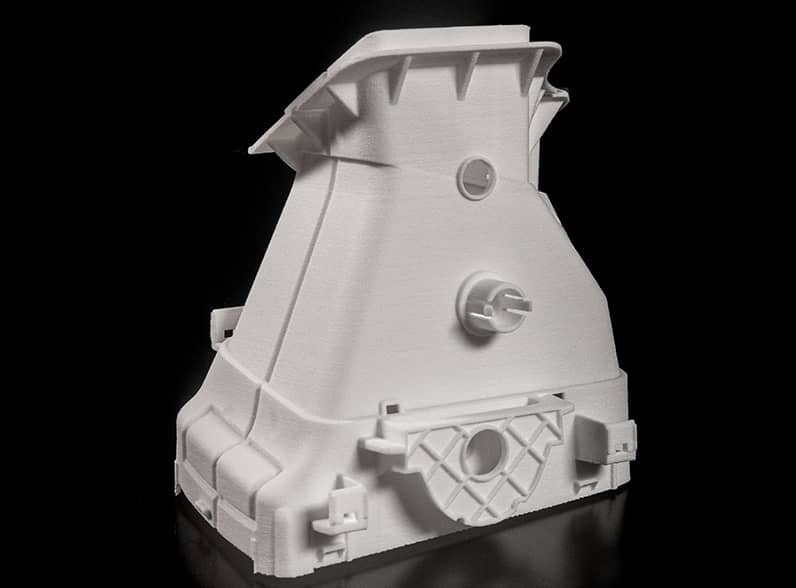
Materialise has introduced Bluesint PA12, enabling 3D printing with 100% recycled powder.
Sustainability is a big buzzword these days, and for good reason. Manufacturing produces significant waste, energy resources are limited, climate change continues, and populations are booming. The “solution” is not — and can never be — just one thing. But with conscious decisions to do better, to recycle more, to use renewable energy sources, “sustainability” can become more of an action plan and less of a buzzword.
Additive Manufacturing Sustainability
Materialise inaugurated its Think-In event today online. While we all miss Materialise World Summit, which was slated to be held again this year in Belgium, this virtual event is allowing a look into the 30-year-old company’s latest industry impacts.
The team offered a strong opening presentation this morning focusing on sustainability — and how and when additive manufacturing makes sense. Just moving production efforts over to additive manufacturing doesn’t immediately make industry more sustainable. It can, certainly, but as always there’s groundwork to establish first. A manufacturing choice must be made to use the best-fit option. Sometimes that’s additive manufacturing — sometimes it’s injection molding, or CNC milling. But there’s a tipping point, which we’ve heard a lot about from companies like Materialise, where turning to 3D printing makes more financial and impactful sense.
“3D printing is often considered a sustainable manufacturing technology but a new Lifecycle Analysis indicates that for large series of identical products, 3D printing has a bigger environmental impact compared to a conventional production technology,” Materialise explains in today’s press release.
Manufacturing has significant impact on the environment, that’s for sure. And Materialise Founder and CEO Fried Vancraen is keeping things real, several times discussing the “greenwashing” that industry can do.
“If you say that additive manufacturing is always a sustainable solution, then you are greenwashing,” Vancraen noted during a press Q&A session. “It’s not de facto green. …Let’s not fool ourselves as an additive manufacturing, let’s make sure we do the right efforts toward sustainability. Otherwise it will backfire sooner or later when consumers discover we have been greenwashing.”
Following some well-researched information regarding comparisons between several 3D printing processes and materials and traditional selections, the Materialise team turned the focus to where efforts make sense. Of their analysis, Materialise explains:
“BASF and Materialise recently conducted a Lifecycle Analysis (LCA) for the production of one million pairs of midsoles, assessing the environmental impact in all stages of the product life. In this case, they compared the environmental impact of three 3D printing technologies with a conventional manufacturing technology: polyurethane casting. The LCA indicates that for large series of identical products, 3D printing is currently not the most sustainable choice and has a bigger impact on climate change and the depletion of fossil fuels compared to the conventional manufacturing technology.”
Bluesint PA12
One of the major areas where 3D printing offers a particular focus on sustainability is in terms of material waste. Additive manufacturing adds material to build up parts, rather than removing material from blocks as is done in milling and other subtractive methods. This inherently means lower material waste, as only the material needed for a build and any supports is used.
But powder-based systems like SLS work with a full bed of powder. That un-sintered powder can in some cases be reused. Most efforts to increase the reusability of powder — from both environmental and cost motivations — focus on increasing the percentage of recycled material that can be used with fresh powder.
Today, though, Materialise announced Bluesint PA12, which “makes it possible to 3D print with up to 100% re-used powder.” Of its development, they explain:
“The search for a more sustainable 3D printing process started seven years ago in the Materialise research lab in Leuven, Belgium. The problem with Laser Sintering is that 3D printing with only used powder – residual powder from a previous 3D print process – creates a surface texture problem called the ‘orange peel’ effect, which makes the printed object largely unusable. The orange peel effect is caused by shrinking that occurs when the powder cools down between two consecutive sintering processes. The existing solution is to mix used powder with fresh powder, which is clearly not sustainable.
By using a 3D printer with multiple lasers, Materialise engineers were able to use one laser for sintering the powder and a second laser to keep the powder above a certain temperature threshold. By preventing the powder from cooling down between two layers, they prevented the shrinking process that causes the orange peel effect. The result is a printed object with similar mechanical and visual properties but printed with 100% recycled powder, drastically reducing waste.”
Successful builds using Bluesint PA12 offer a rougher surface finish, the team noted in their presentation, but similar mechanical properties to existing options.
The company intends to operate enough systems running the new material that they estimate that the startup phase, running throughout 2021, they will “re-use more than five tons of powder that would normally become waste.”
But they don’t want to be the only ones running Bluesint PA12. Materialise is opening up a beta program for selected customers to participate in the market validation process. Ahead of broader commercial access to the new material, the beta program is open for applications now. Materialise says that participating companies will:
- Get first-in-market access to our new sustainable solution
- Help us fine-tune the process to meet your requirements
- Have a more sustainable material option produced by a reliable and validated process if the resulting process is commercialized
Via Materialise
